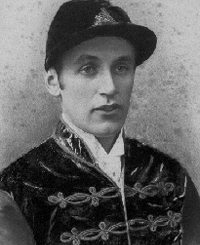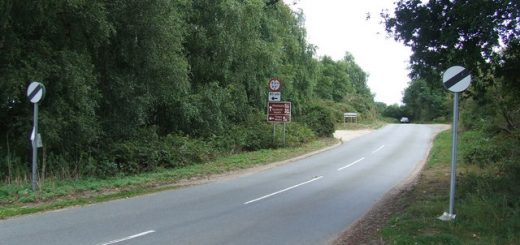Dieppe Raid, Normandy
The Dieppe Raid was a reconnaissance in force (division strength) to test the feasibility of an amphibious assault on German occupied France with the intention of attacking and capturing a defended port town, holding it for a short time then retreating with all gathered intelligence after destroying its strategic buildings and defences. Information and experience from the raid would prove vital when planning the D-Day (6 June 1944) invasion of Normandy and the necessary techniques and equipment that would be required. A decade after the attack the ghostly sounds of battle were reported by a tourist visiting Dieppe.
The raid was known as Operation Jubilee (based on an earlier idea called Operation Rutter) and was planned by Admiral Louis Mountbatten, 1st Earl Mountbatten of Burma (born 25 June 1900 – died 27 August 1979). The main element of his attack force was comprised of the 4th Canadian Infantry Brigade (consisting of The Essex Scottish Regiment, The Royal Hamilton Light Infantry, The Royal Regiment of Canada) and the 6th Canadian Infantry Brigade (including Les Fusiliers Mont-Royal, The Queen’s Own Cameron Highlanders of Canada and The South Saskatchewan Regiment) of the 2nd Canadian Infantry Division (formed 1 September 1939) commanded by Major General John Hamilton Roberts (born 21 December 1891 – died 1962). Also there were some platoon sized elements of the 5th Canadian Infantry Brigade’s Black Watch of Canada. The force also included No.3 Commando, No. 4 Commando (including a unit of fifty elite American Army Rangers) and No. 10 (Inter Allied) Commando. Armoured support for Operation Jubilee was provided by the 14th Armoured Regiment (the Calgary Regiment) with fifty-eight Churchill tanks.
On 19th August 1942 the land force of Operation Jubilee numbering just under 5000 Canadians and 1075 British soldiers were carried across the English Channel to Dieppe with 237 vessels and landing craft of the Royal Navy (including the destroyers HMS Albrighton, HMS Berkeley, HMS Bleasdale, HMS Brocklesby, HMS Calpe, HMS Fernie, HMS Garth, ORPŚlązak) and supported by 74 Squadrons (including 66 fighter squadrons) of the Royal Air Force.
 At 5.00am the attack on Dieppe began. Each element of the Allied forces was assigned targets and given designated landing areas, a series of beaches code named Blue, Red, White, Green, Yellow and Orange were targeted.
At 5.00am the attack on Dieppe began. Each element of the Allied forces was assigned targets and given designated landing areas, a series of beaches code named Blue, Red, White, Green, Yellow and Orange were targeted.
Blue Beach (Puys) – The Royal Regiment of Canada.
White & Red Beach – The Essex Scottish Regiment, Royal Hamilton Light Infantry, Les Fusiliers Mont-Royal, and the 14th Armoured Regiment.
Green Beach – South Saskatchewan Regt, Queen’s Own Cameron Highlanders.
Yellow Beach – No 3 Commando
Orange Beach – No 4 Commando
 Opposing them was a force numbering 1500 soldiers of the German 302nd Infantry Division (302nd Artillery Regiment, 570th Infantry Regiments, 571st Infantry Regiments, 572nd Infantry Regiment, 302nd Reconnaissance Battalion, 302nd Anti-tank Battalion, 302nd Engineer Battalion and 302nd Signal Battalion). Forewarned by their agents of the coming attack they took up defensive positions covering the likely landing sites.
Opposing them was a force numbering 1500 soldiers of the German 302nd Infantry Division (302nd Artillery Regiment, 570th Infantry Regiments, 571st Infantry Regiments, 572nd Infantry Regiment, 302nd Reconnaissance Battalion, 302nd Anti-tank Battalion, 302nd Engineer Battalion and 302nd Signal Battalion). Forewarned by their agents of the coming attack they took up defensive positions covering the likely landing sites.
The German resistance was hard and by 10.50am the attack had stalled and the Allies were forced to order a retreat back into the English Channel, which was completed by 2.00pm. The Battle for Dieppe had been described as a bloodbath and the casualty figures are very sobering. ‘I have not witnessed images more terrible. In one landing craft the entire crew of about forty men had been wiped out by a direct hit. On the water we could see bits of wreaks, ships in ruins, corpses floating and soldiers wrestling with death. In Paris there was jubilation. The enemy’s operation was smashed in just over nine hours!’ – [Quote from a German Officer].
Casualities: (including wounded and those captured)
Canadians – 3,367
British Commando’s – 275
Germans – 591
The Royal Navy lost 550 men, a destroyer and 33 landing craft.
The RAF lost 153 airmen and 106 aircraft.
 There was one key success to the Operation Jubilee. No. 4 Commando under the command of Lt Colonel Simon Christopher Joseph Fraser, 15th Lord Lovat (born 9 July 1911 –died 16 March 1995) with the US Army Rangers accomplished their part of the mission, neutralising a battery of six 150mm coastal guns and withdrawing back to England with low casualties. For this action Lord Lovat was awarded his DSO (Distinguished Service Order).
There was one key success to the Operation Jubilee. No. 4 Commando under the command of Lt Colonel Simon Christopher Joseph Fraser, 15th Lord Lovat (born 9 July 1911 –died 16 March 1995) with the US Army Rangers accomplished their part of the mission, neutralising a battery of six 150mm coastal guns and withdrawing back to England with low casualties. For this action Lord Lovat was awarded his DSO (Distinguished Service Order).
I would love to cover all aspects of the battle and detail the many stories of personal heroism, but that is beyond the scope of this article. Needless to say, the information gathered and lessons learned through the actions of the Canadian forces at Dieppe, proved invaluable to the planners of D-Day.
Haunted Battlefield?
On 4th August 1951 Mrs Dorothy Naughton and her sister in law Agnes were on holiday in Puys near Dieppe. At 4.00 am Dorothy was awakened by the sounds of battle coming from the beach, shouts, gunfire, explosions, fighter aircraft and the sound of landing craft beaching and unloading troops. Agnes awoke twenty minutes later and they both went out onto the balcony and listened to this experience unfolding over a period of three hours. According to The Encylopedia of Ghosts and Spirits by John and anne Spencer, Mrs Naughton had heard similar noises but much fainter the previous Monday. At Puys they would have been close to Blue Beach where The Royal Regiment of Canada with some platoon sized units of The Black Watch of Canada were delayed by twenty minutes and their planned smoke screen had lifted before they managed to land. German defenses pinned the Canadians on the beach. The Royal Regiment of Canada brought 556 men to Blue Beach, 264 were captured and 200 were killed in action.
Dorothy and Agnes made a record of their experience, noting the flow and timing of the battle sounds. The Society for Psychical Research is said to have researched their experience and found their description of the sounds they heard matched the reported battle that took place a decade earlier.





Recent Comments